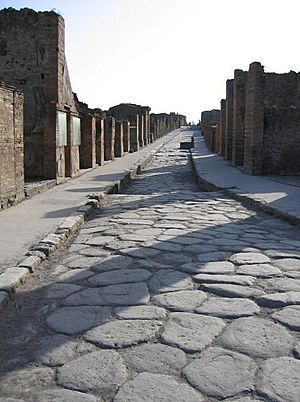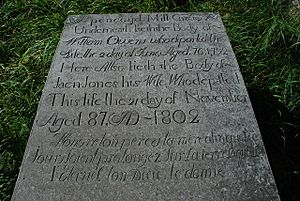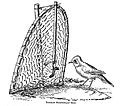Stone slab facts for kids
A stone slab is a large, flat piece of stone that isn't very thick. People often use them for covering floors, walls, or as special markers for graves.
Think of a stone slab as:
- A big, flat stone that isn't thick.
- A flat stone, usually thin and shaped like a rectangle.
Contents
Stone Slabs in Ancient Tombs
Many ancient structures called dolmens were built using very large stone slabs. These dolmens were often tombs. They sometimes had a path or corridor leading to them, made from stone slabs or dry stones. The main burial room inside could be different shapes, like rectangular, round, or oval. Some dolmens even had a door cut right into one or more tall stone slabs.
How Stone Slabs are Used in Building

Stone slabs are very useful in building! Their main jobs are for making pavements (like sidewalks or floors) and for roofs. But they can be used for many other things too:
- Balconies can be made from a single large slab.
- Dry stone walls (walls built without mortar) often use slabs for strength.
- The bottom part of some fireplaces is made from stone slabs.
- In churches, the altar stone (the top part of the altar) can be a stone slab.
- Some rustic tables have tops made from stone slabs.
- Slate slabs are very popular for making roofs because they are strong and waterproof.
Cooking with Stone Slabs
Did you know you can cook on a stone slab? It's a cooking method called "to the slab." It's similar to cooking "on the grill" or "on the griddle." You place food like meat, fish, or vegetables on a hot stone slab that's sitting over a fire. You can add oil, butter, or other seasonings to make your meal delicious!
- This way of cooking was very popular in mountain areas, especially among farmers and shepherds. Today, people everywhere enjoy cooking this way.
- Sometimes, the same slab used for cooking can also be used to serve the food! You can take it off the fire and bring it right to the table. Because the slab stays hot longer than other dishes, your food will stay warm for a longer time.
Stone Slabs as Grave Markers
For thousands of years, people have used stone slabs to cover graves. These can be natural stones or specially carved ones. Over time, the idea of a "grave slab" became linked to a flat, thin, and often polished stone used as a tombstone. For example, the tomb of King Peter the Great used a stone slab.
Grave slabs usually have writing on them. This often includes the name of the person who died and their birth and death dates. The writing is usually on the front, but sometimes it can be on the back or around the edges. Some families even ask for a message to be written on the part of the slab that faces the ground. Besides names and dates, grave slabs can also have special messages praising the person or quotes from religious texts, like "Requiescat in pace" (which means "May they rest in peace").
Related Pages
Images for kids
See also
 In Spanish: Losa de piedra para niños
In Spanish: Losa de piedra para niños






